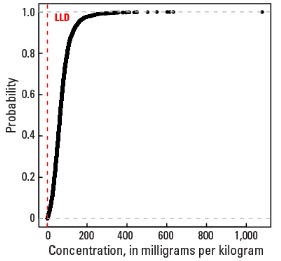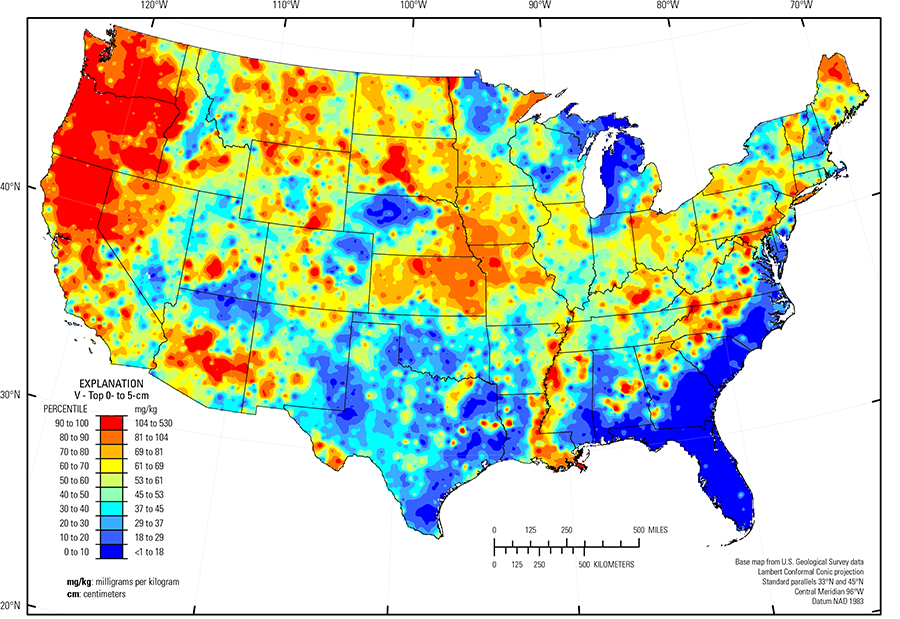
The purpose of these interpretive discussions is to provide a perspective on regional- and national-scale variations in element and mineral distributions in soils and their likely causes. The significant spatial variations shown by most elements and minerals can commonly be attributed to geologic sources in underlying parent materials, but other spatial variations seem clearly related to additional factors such as climate, the age of soils, transported source material, and anthropogenic influences. We attempt to distinguish the influence of these various factors on a regional and national scale. Numerous more local features might similarly be related to these same factors, but these features also have some probability of being an artifact of a random sampling of variable compositions, so that there is some probability of samples with similar compositions occurring in clusters of two or more adjacent sites by chance. Distinguishing such random occurrences from true variability is beyond the scope of the data from which these maps are constructed. Some caution, therefore, is advisable in interpreting the significance of these more local features unless some unique sources or processes can clearly be related to them.
Vanadium (V) is a metallic element used primarily as a steel additive. Vanadium–steel alloys are used in armor plate, tools, axles, and piston rods. The element is essential for some organisms, including humans; however, some V compounds are toxic. More information about the toxicity of V (or other elements and substances) and its potential negative human health impacts can be found at the Agency for Toxic Substances and Disease Registry (ATSDR) website, or click to download a fact sheet about V.
Vanadium in soil is largely inherited from soil parent materials. The abundance of V in the Earth's upper continental crust is estimated to be 106 milligrams per kilogram (mg/kg) (Hu and Gao, 2008). Vanadium substitutes for iron (Fe), aluminum (Al), and titanium (Ti) in ferromagnesian minerals common to mafic igneous and metamorphic rocks, such as basalt, gabbro, and amphibolite. Mafic rocks, on average, contain about 260 mg/kg V. In the soil environment, ferromagnesian minerals, such as pyroxene, olivine, amphibole, and serpentine, are susceptible to weathering. Vanadium released from its original silicate minerals by erosion and weathering can absorb to clay. Thus, mafic rocks can be an original source for V in shale, as well as in unconsolidated materials such as alluvial, eolian, or glacial deposits. Shale contains, on average, about 130 mg/kg V. Of the other common rock types, granite contains about 70 mg/kg V, sandstone has about 20 mg/kg, and limestone about 15 mg/kg.
The distribution of mineral resource deposits with V as a commodity (major or minor) in the United States, extracted from the U.S. Geological Survey (USGS) Mineral Resource Data System (MRDS) website, can be seen by hovering the mouse here. Statistics and information on the worldwide supply of, demand for, and flow of V are available through the USGS National Minerals Information Center (NMIC) website.
In our data, the median concentration of V is 64 mg/kg in the soil C horizon, 54 mg/kg in the soil A horizon, and 53 mg/kg in the top 0- to 5-cm layer (see the summary statistics [open in new window]). Less than 1 percent of all analyzed soils have V concentrations less than the lower limit of determination (LLD) of 1 mg/kg. The broad spatial map patterns for V among the three sample types are generally similar to one another.
The distribution of V in the soil C horizon largely reflects the distribution of soil parent material sourced from mafic rocks or fine–grained sedimentary rocks, as well as from more recent alluvial and eolian deposits sourced from these rock types. Examples of such areas (and dominant soil parent materials) include:
- Pacific Northwest and northern California (mafic volcanic rocks, including the Columbia River basalt (Swanson and Wright, 1981) and basalt and andesite of the Cascade Range);
- Mogollon Transition (USDA, 2006), Arizona (basalt and alluvium from mafic rocks);
- Southern half of the Wasatch and Uinta Mountains (USDA, 2006) in west-central Utah (mafic volcanic rocks);
- Rolling Pierre Shale Plains (USDA, 2006), South Dakota (Cretaceous shale);
- Eastern Kansas (limestone and shale);
- Central Kentucky (thin black shale unit);
- Southern Blue Ridge (Fenneman and Johnson, 1946) (weathered metamorphosed mafic rocks);
- Piedmont (Fenneman and Johnson, 1946) from Georgia to New Jersey (weathered metamorphosed mafic rocks); and
- Eastern Texas (Fe–rich sandstone, siltstone, and claystone).
In the Upper Midwest, melting of glacial ice following the multiple late Wisconsinan period advances (16,000 to 12,000 years ago) left the region north of the southern glacial limit (Soller and others, 2012) mantled with a blanket of mixed, immature sediments from which present–day soil developed. Individual ice lobes (Grimley, 2000) created distinct patterns in soil mineralogy and geochemistry because of varying provenance and ice transport paths. In northeastern Minnesota 'red' quartz– and feldspar–rich till has a local Precambrian mafic rock provenance (Duluth Complex) and a more distant Precambrian crystalline provenance. Carbonate– and shale–rich 'gray' till in western Minnesota, North Dakota, South Dakota, and Iowa were derived from Cretaceous sedimentary rocks (dolostone, limestone, and shale). Soil with higher V concentrations in the Red River Valley of the North (USDA, 2006) along the northern Minnesota–North Dakota border formed in clayey, calcareous glacial lacustrine sediments of Glacial Lake Agassiz. Soil with somewhat elevated V concentrations in western Ohio developed on glacial deposits that incorporated black shale clasts. Shale taken up by the glacial ice of the Lake Michigan lobe and the Huron–Erie lobes (Grimley, 2000) was spread beyond areas where black shale is near the surface. Soil south of the southern glacial limit (Soller and others, 2012) in southern Iowa and northern Missouri that developed in loess are relatively enriched in V compared to soil developed on till.
Lower concentrations of V in soil occur in areas where original mafic minerals were largely absent in the soil parent materials. Examples include:
- Colorado Plateau (USDA, 2006) (quartz–rich eolian deposits and sandstone);
- Northern Mojave Desert (USDA, 2006) (quartz–rich eolian and alluvial sands);
- Texas carbonate terrane (limestone, dolostone, chalk, and marl)
- Nebraska Sand Hills (USDA, 2006) (an area of quartz– and plagioclase–rich unconsolidated sand dunes and sand sheets);
- Central and Southern High Plains of eastern New Mexico and northwestern Texas (quartz–rich eolian sands and alluvial sediments); and
- Florida (marine carbonate bedrock and quartz–rich sands).
The Gulf and Atlantic Coastal Plain (Fenneman and Johnson, 1946) is bisected by the Southern Mississippi River Alluvium and the Southern Mississippi Valley Loess (USDA, 2006). Alluvial sediments have deposited in the Mississippi River valley as the river flooded in recent geologic time. When these sediments dried, winds picked up the fine material and deposited it in thick loess sheets, mainly along the east side of the river valley. The youngest loess sheets are about 10,000 years old. A pattern of higher V in soil developed on these young sediments reflects long–range transport of V–bearing material from areas in the upper part of the Mississippi River drainage basin.
Statistics - 0 TO 5 CM
| Number of samples | 4,841 |
| LLD | 1 mg/kg |
| Number below LLD | 12 |
| Minimum | <1 mg/kg |
| 5 percentile | 11 mg/kg |
| 25 percentile | 33 mg/kg |
| 50 percentile | 53 mg/kg |
| 75 percentile | 74 mg/kg |
| 95 percentile | 136 mg/kg |
| Maximum | 530 mg/kg |
| MAD | 31.1 mg/kg |
| Robust CV | 58.7% |
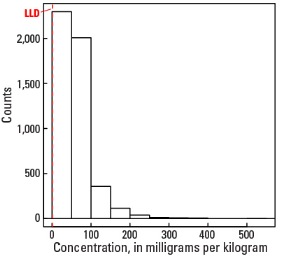
Histogram
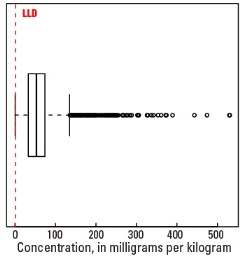
Boxplot
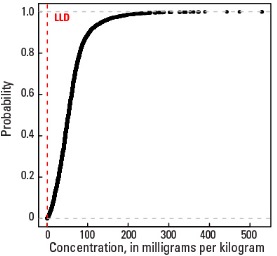
Empirical cumulative distribution function
Statistics - A Horizon
| Number of samples | 4,813 |
| LLD | 1 mg/kg |
| Number below LLD | 10 |
| Minimum | <1 mg/kg |
| 5 percentile | 11 mg/kg |
| 25 percentile | 33 mg/kg |
| 50 percentile | 54 mg/kg |
| 75 percentile | 76 mg/kg |
| 95 percentile | 139 mg/kg |
| Maximum | 524 mg/kg |
| MAD | 31.1 mg/kg |
| Robust CV | 57.7 % |
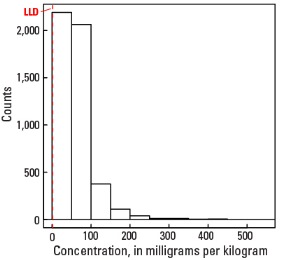
Histogram
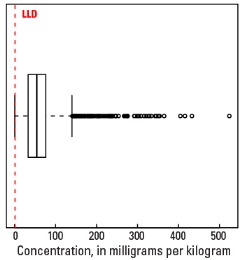
Boxplot
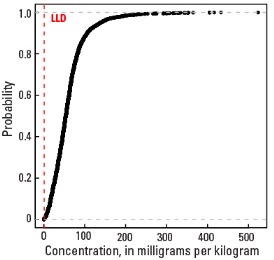
Empirical cumulative distribution function
Statistics - C Horizon
| Number of samples | 4,780 |
| LLD | 1 mg/kg |
| Number below LLD | 5 |
| Minimum | <1 mg/kg |
| 5 percentile | 14 mg/kg |
| 25 percentile | 41 mg/kg |
| 50 percentile | 64 mg/kg |
| 75 percentile | 92 mg/kg |
| 95 percentile | 158 mg/kg |
| Maximum | 1,080 mg/kg |
| MAD | 37.1 mg/kg |
| Robust CV | 57.9 % |
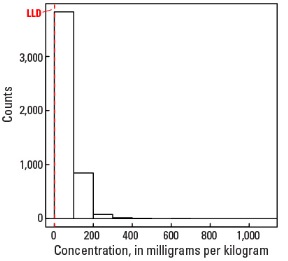
Histogram
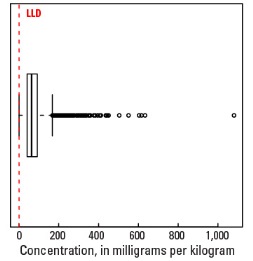
Boxplot
